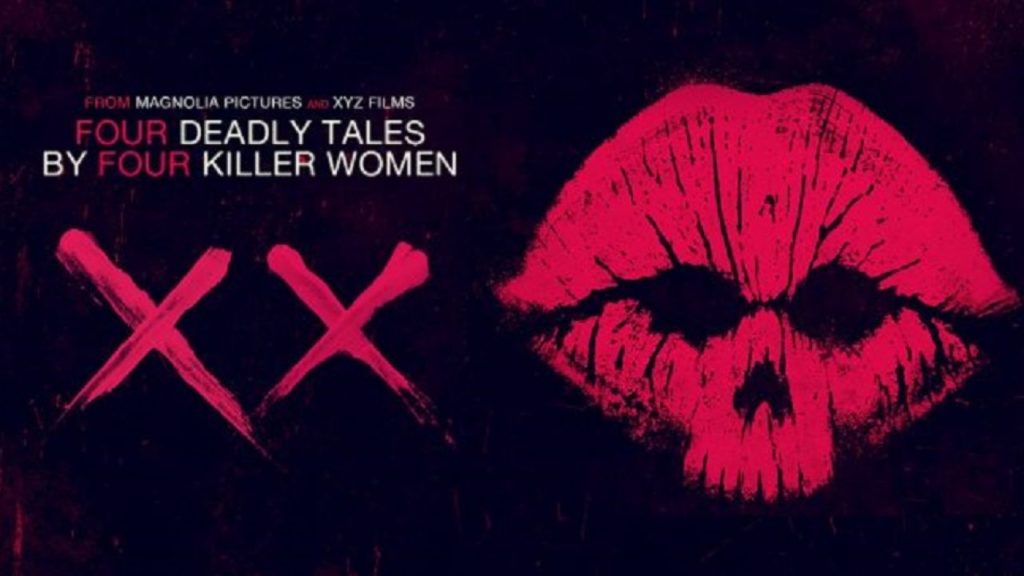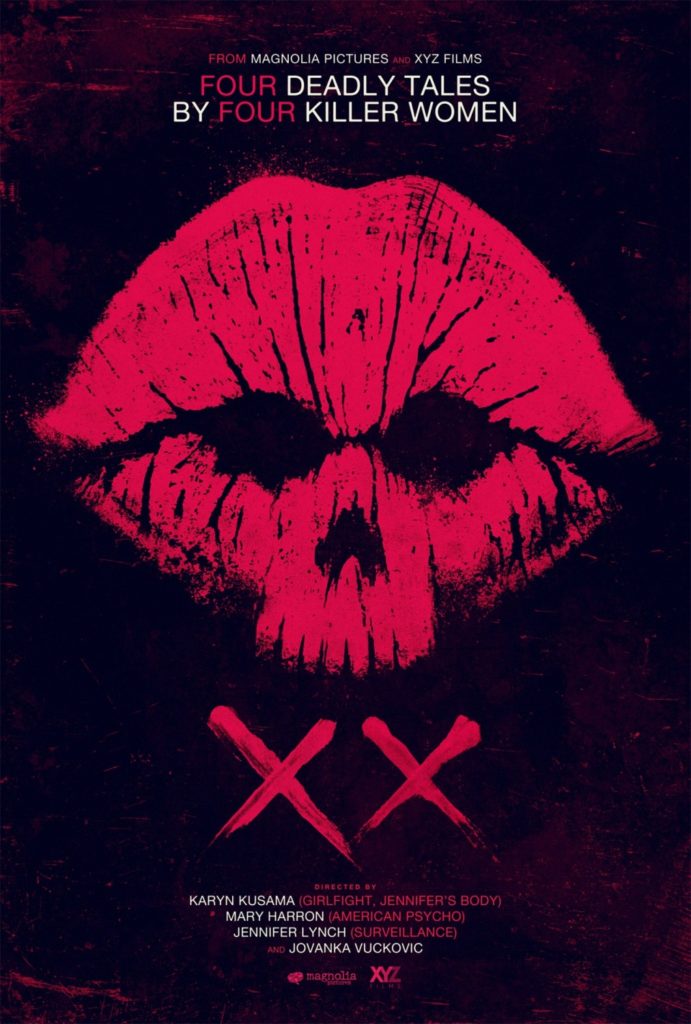Welcome back to Sound Off!, a semi-regular column where members of Speculative Chic gather together to chat about the latest BIG THING in entertainment. This time, we’re peering through the dollhouse to see all the stories told in the new horror anthology movie XX, which premiered in the United States on Friday, February 17, 2017.

Sound Off! is meant to be a group of reactions, but not necessarily a review. After all, while we are all individuals, even mutual love of something (or hate) can come from different places. You may find everything from critique to fangirling to maybe even hate-watching, but it’s safe to say that if you haven’t yet seen XX and you read this post, you WILL be spoiled in some form or fashion.
Now, join our Editor-in-Chic Shara White as she talks about XX! [Note: This post includes minor set-piece spoilers in the context of critical analysis that should not ruin your enjoyment of any of the short films.]
Shara: This movie caught my eye when my husband and I watched the trailer on Apple TV. At the time, I figured this would be the kind of thing that would be rentable on iTunes the same day it was released in theaters, and I was right! XX is a unique movie by my own standards: one film made up of four short films, all directed by women, and it’s horror to boot. I know women have directed horror films before, but I was drawing a blank until I remembered Jennifer Kent’s The Babadook (2014). My drawing a blank doesn’t mean much, mind you: I don’t often pay attention to who’s directing the films I’m watching, but that’s because I assume it’s a man unless I’m told otherwise, so of course, being told that XX features four different female directors caught my eye. And since February is “Women in Horror” month, it seems like a fine time to step back from my own biases when it comes to film and take a look at what women are doing in the medium, and XX gave me four opportunities to do just that!
In truth, there’s five, if you include the super-creepy and almost-a-short-film-in-and-of-itself stop-motion animated segments that frame the overall film and transition between each piece.
 Despite some of the more familiar names you see on the promo posters online (Jennifer Kent, whom I mentioned above, and also Mary Harron, who directed 2000’s American Psycho), the actual directors are as follows:
Despite some of the more familiar names you see on the promo posters online (Jennifer Kent, whom I mentioned above, and also Mary Harron, who directed 2000’s American Psycho), the actual directors are as follows:
Sofia Carrillo, who directed the stop-motion animated frame story
Jovanka Vuckovic, who directed “The Box” (based on a short story by Jack Ketchum)
Annie Clark, who directed “The Birthday Party” (which she co-wrote with Roxanne Benjamin)
Roxanne Benjamin, who directed and wrote “Don’t Fall”
Karyn Kusama, who directed and wrote “Her Only Living Son”
The first thing I want to say: if you have a choice between renting this on iTunes versus seeing this on the big screen? iTunes all the way. Not just because it’s cheaper, because obviously that’s always going to be a better option, but the film as a whole, while interesting, just didn’t strike me as being worth movie theater prices. Maybe it’s because I’m so used to anthology pieces being on a smaller screen, and seeing it on the bigger screen would’ve been bizarre at best. It’s also just not the kind of film that begs to be seen on the big screen, which sounds damning and maybe is, but on the smaller screen with a price tag of $6.99? I totally got my money’s worth.
That said, I found the films themselves to be rather uneven. Short films leave very, very little room for characterization, let alone a lot of time to build a lot of tension or suspense, so every minute has to be used to its maximum potential. Each film told its own unique story, and each story had its own style, but because of the limited amount of time for development, not every story felt complete or even satisfying by the end.
So it’s telling that the strongest story of the bunch was adapted from an existing story by an established horror writer with a long career: “The Box,” adapted by a Jack Ketchum story, had a clear arc, and while it certainly left me with questions, I never questioned the horror of what was happening and I was totally engaged in it. I am, however, a little peeved that the most complete story, for me, was ironically penned by a guy.
The misses for me were “The Birthday Party” and “Don’t Fall.” The former was something a bit absurd and funny, which is bizarre in horror, and it never really struck me the way I think it was meant to, though one could certainly look at “The Birthday Party” and examine it through the lens of the horror of domestic suburbia and how alien and frightening it is, especially from the point of view of a child, which is maybe what it was trying to accomplish?
“Don’t Fall,” however, was just sloppy: it took a tired trope and layered it with another tired trope and turned it into a slasher piece that had no story and no satisfaction. With slasher films, you usually want the characters to die for being so stupid. With this short, I was more concerned about the writer using the tropes as a shortcut for story and being confused as to why the heroine was the character singled out for, well, you’ll just have to watch the film and explain it to me, because what we saw just wasn’t enough to justify what happened and frankly, I’m still not sure what happened, let alone why.
And then we got “Her Only Living Son,” which being the last piece in the anthology, I expected to be powerful, and it was. Not only did we get Kyle Allen playing the titular son giving me serious A Knight’s Tale Heath Ledger vibes (which in and of itself unsettling), I got to watch Christina Kirk, whom I’m used to seeing in comedic roles (Better Off Ted, Powerless) stretch her dramatic chops, and that was really rewarding. The plot here too was a little tropey, but Kirk’s devotion to her role really made up for it, and I was more than engaged with this short film and I couldn’t wait to see how it turned out.
But I’ve got to give a special shout-out to the stop-motion animated frame story: that, out of all the four films, had to be the freaking creepiest thing out of the hour and twenty minutes. Seriously. It was gorgeous and haunting and disturbing and beautiful, and almost worth the iTunes ticket price alone.
So you might be wondering: if the stories were hit-and-miss, what’s the point? What did these directors bring that, say, a dude wouldn’t? Well, let me tell you: it’s a female point of view: each film is told through the female gaze, and in two cases, women are clothed in nightclothes. In one specific case, the female lead is in a very low cut, satiny nightgown the entire film. And you know what’s awesome? There isn’t one moment, at any time, where the camera sexualizes these moments. Not one. And I found that interesting, because with a male director, the male gaze would have been tempted to sexualize the female lead and what she was wearing, or at the very least, would’ve been immediately aware of what she was wearing, you know? In the two cases I mention, it took me a minute to realize specifically what the women were wearing, and then it took a moment longer to realize that in someone else’s hands, these scenes would’ve had a very different tone to them.
XX was a rather interesting experiment. I wasn’t exactly sure what I was getting into Friday night when my husband and I rented the film, but I’m more than glad we rented it. Certainly it’s following in the footsteps television has long paved the way for, though I have to wonder if some of the weaknesses found in the tales is a result of personnel replacements along the way. As previously mentioned, Jennifer Kent and Mary Harron were originally attached to this project if the promotional art is to be believed, and they aren’t now, so perhaps what I’m seeing is a result of a rush job, which is a shame. Regardless, in the comfort of your own home, for $6.99, it’s worth curling up on the couch for a few good scares, and if you’re the academic sort, you can really have some fun analyzing the material! I’m curious to see what horror buffs have to say about this, particularly those who are familiar with these writers and directors!

Why is horror so difficult? It’s like: if it’s really really good, I’m scared to see it, because it’ll be too disturbing. But if it’s bad, then it’s not worth seeing. It’s a hard genre, all around, it seems like. In the written form too.